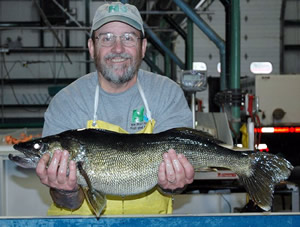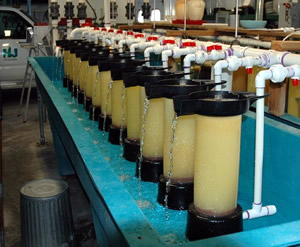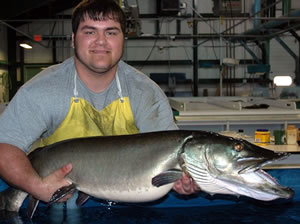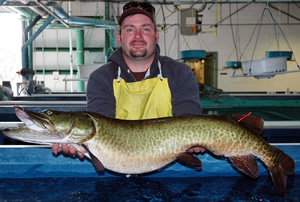|
Hackettstown State Fish Hatchery - 2010 Broodstock Collection
by Craig Lemon
Hatchery Superintendent
February 1, 2011
Each year, staff from the NJ DEP Division of Fish and Wildlife's Hackettstown Hatchery travel to north Jersey lakes to collect broodstock (adult fish capable of spawning) through netting. The purpose of this effort is to provide the eggs from which fish are raised at the hatchery. All fish raised at the Hackettstown Hatchery are stocked in public waters throughout the state to provide recreational fishing for licensed anglers and their families.
The 2010 spring trapnetting season began right on schedule as the ice melted off of Budd Lake and a crew from the hatchery set 3 trapnets on March 15th. The two South Dakota style nets and one Pennsylvania style net were set along the shore to capture northern pike to transport back to the hatchery as broodfish for spawning.
The nets were fished from March 15th through March 21st, capturing a total of 155 pike in 6 days - this compares to 151 in 12 days of fishing in 2009. This year's catch consisted of 91 males and 35 females. Budd Lake water temperatures ranged from 40-46 degrees. The nets also captured good numbers of the following species: black crappie (1,624), brown bullhead (491), white perch (459), and yellow perch (420). Eight other species of fish were captured, including largemouth and smallmouth bass and chain pickerel.
|
The male pike averaged 2.86 pounds and 23.2 inches, ranging from 0.55-5.35 pounds and 13.6-29.4 inches long. The females averaged 6.9 pounds and 30 inches long, ranging from 0.85-14.6 pounds and 15.5-38.4 inches long. Of the 35 females, 21 of them either came in ripe with eggs or ripened while being held in hatchery tanks. The 21 females produced 820,000 eggs, averaging about 40,000 eggs each.
The eggs hatched at a rate of 65%, which is the long-term average hatching percent. Pike eggs hatch in 10 days and the fry swim up, looking to feed, in another 5 days. The pike fry were stocked in June when they reached their target size of between 6 and 7 inches.
|
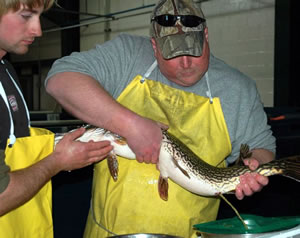 Seasonal
technician Ryan Votta assists Crew Supervisor Ed Conley stripping pike eggs.
Seasonal
technician Ryan Votta assists Crew Supervisor Ed Conley stripping pike eggs.
Click to enlarge |
With New Jersey experiencing well above normal temperatures, the crew quickly focused their efforts to Swartswood Lake in search of walleye broodfish. A single Pennsylvania style trapnet with some modified wings was set in the mouth of Neldon Brook. The net was fished for 5 days capturing 328 walleyes, comparing nicely with the 344 captured in 6 days in 2009. (See Swartswood Broodstock Data Collection for information on the impressive fish from Swartswood Lake.)
|
|
The catch was made up of 201 males and 127 females. Swartswood's water temperatures ranged from 45-49 degrees. The net captured eight other species, but in very low numbers. This could be attributed to the fact that the walleyes are migrating from different sections of the lake towards Neldon Brook to run up and spawn, while the cool water temps are keeping many of the other species movements down.
The male walleyes averaged 3.1 pounds and 19.9 inches, ranging from 1.55-4.85 pounds. The females averaged 4.74 pounds and 22.1 inches, ranging from 2.3-10.6 pounds and 17.6-28.2 inches. A large number, 48 of the 127 (38%), of the females captured weighed over 5 pounds.
The netting crew once again hit the peak of the spawning season as 97 of the 127 (76%) females captured were spawned. The 97 females gave 9.78 millions eggs, averaging about 100,000 eggs per fish. The crew set up 1 million 3-day old fry into 2 large hatchery ponds for growout and another couple million fry were stocked in the Delaware River from Milford, PA, to Belvidere, NJ. |
The hatchery pond production of walleye fingerlings was about 300,000 two-inchers and 35,000 four-inchers in 2010.
On March 31st, the Hackettstown crew set its sites on muskellunge broodstock. Two Pennsylvania style trapnets were set on Greenwood Lake in the very shallow southern end. Water temps warm up quickly on the NJ end of Greenwood Lake, drawing in male and female muskies searching for a location to spawn.
| During the eight day period from March 31st - April 7th, the crew captured 34 adult muskies. The nets also captured 82 walleyes weighing up to 9.75 pounds with many of the females over 5 pounds. There were also hundreds of yellow and white perch, black crappie, sunfish and alewives. Water temperatures ranged from a low of 44 to a high of 59, quite a large swing for an eight-day period on such a large lake.
The Greenwood catch was made up of 16 males and 18 females. The males averaged 13 pounds and 37.6 inches, ranging from 9.65-16.6 pounds and 34.6-40 inches. The females averaged 21.9 pounds and 42.8 inches and ranged from 11.3-33 pounds and 37-50 inches. Of the 18 females captured, 12 of them were spawned giving just over 1 million eggs. A few of them had already spawned in the lake (spent) and the others did not come ripe during their time at the hatchery.
|
|
Continuing with the muskie collection, the crew moved netting operations to Echo Lake Reservoir on April 7th. Four trapnets were set in the coves of Echo on the 7th and fished until April 23rd. The nets captured 34 muskies, the second highest total behind the old record of 36 in 2008. They also captured large numbers of alewives (826), sunfish (376), black crappie (438), and yellow perch (213). Other gamefish captured included chain pickerel (46), smallmouth bass (6), and largemouth bass (4). Water temperatures ranged from 47-58 degrees.
|
|
The Echo Lake Reservoir catch was split 12 males and 22 females. The males averaged 12.2 pounds and 36.8 inches, ranging from 5.55-15.2 pounds and 24-41.8 inches. The females averaged 20.2 pounds and 43.9 inches ranging from 11.45-30.8 pounds and 36.5-49 inches.
Of the 22 females captured at Echo Lake, 17 were spawned producing 800,000 eggs, about 50,000 per female. A total of 29 females from the two lakes were spawned producing about 1.8 million eggs.
|
The eggs hatched at a rate of 40%, which is 5-10% lower than normal. This could partially be due to the fluctuating lake water temperatures during breeding season. The 700,000 fry then went through a 7-10 day period where they feed off their yolk sacs. They are then called swimup fry as they lift off the tank bottom and began free swimming.
Hatchery workers then went through a tough, month-long period when these tiny fry are fed 15 days of cooked brine shrimp and then a mix of shrimp and dry feed. At that time a good percentage have taken to the dry food diet because the live shrimp diet is discontinued. The muskie fry are raised both indoors in hatchery tanks and outdoors in earthen ponds. The production target was 10,000 to 12,000 ten-inch fingerlings. They reached this size by October 15th in time to be float-stocked into lakes, rivers and reservoirs.
| For the 4th straight season the Division of Fish and Wildlife received a request from the NY Dept. of Environmental Conservation's South Otselic Fish Hatchery to provide them with 100,000 tiger muskellunge fry. Hatchery staff were successful in providing them with a mix of both crosses (female pike/male muskie and vice versa).
On April 10th, NY hatchery personnel picked up 50,000 female northern pike x male muskellunge cross tigers, and then on May 5th they made the trip for 50,000 female muskellunge x male northern pike tigers. Hackettstown staff used 40 male northern pike with 7 female muskies and 12 male muskies with 10 female northerns to produce the 100,000 tiger fry requested.
The Hackettstown Hatchery relies on the productivity of wild populations of northern pike, muskellunge and walleye to provide the broodstock to support the division's stocking programs. Within a week of spawning all fish are returned to the waters where they were collected.
|
|
All adult muskies handled at the hatchery over the past five years can be identified by orange streamer tags inserted near the base of the dorsal fin. The tags bear the message, "CALL HACKETTSTOWN HATCHERY 908-852-4950" along with a tag number. Three previously tagged fish from Greenwood Lake and eight from Echo Lake were captured during the 2010 broodstock collection. Anglers who call in to report catching a tagged fish will be told when the fish was tagged, and its length and weight at the time of tagging. Such reports aid in assessing division stocking programs and in formulating management plans.
In coordination with State fisheries biologists, the Hackettstown Hatchery raised the following numbers of muskellunge, tiger muskies, and walleyes to meet the state's needs for for 2010:
24,520 northern pike fingerlings for stocking in:
Cranberry Lake (Sussex County); Pompton Lake and Pompton River (Passaic
County); Spruce Run Reservoir (Hunterdon County); Budd Lake (Morris
County); Farrington Lake (Middlesex County); Deal Lake (Monmouth County);
Millstone River and the Passaic River.
11,111 muskellunge for stocking in:
Greenwood Lake, Monksville Reservoir and Echo Lake Reservoir (Passaic
County); Lake Hopatcong (Morris and Sussex Counties), D&R Canal
10-mile stretch (Somerset and Mercer Counties); Manasquan Reservoir
(Monmouth County); Carnegie Lake and Mercer Lake (Mercer County);
Mountain Lake and Furnace Lake (Warren County); Shenandoah Lake
(Ocean County); Little Swartswood Lake (Sussex County); and DOD Lake (Salem County).
207,950 walleyes for stocking in:
Lake Hopatcong (Morris County), Swartswood Lake (Sussex County),
Greenwood Lake (Passaic County), Canistear Reservoir (Sussex County),
Monksville Reservoir (Passaic County) and the Delaware River (Sussex and Warren Counties).
The hatchery also raises 13 other species of fish for waters throughout the state - see the Hackettstown Hatchery Production and Stocking Summaries for details.
Below are summary tables of fish collected in spring, 2010.
NORTHERN
PIKE
| WATERBODY |
# DAYS NETS WERE SET |
# FISH CAUGHT |
AVERAGE LENGTH (INCHES) |
LARGEST FISH (INCHES) |
AVERAGE WEIGHT (POUNDS) |
LARGEST FISH (POUNDS) |
| BUDD LAKE |
6 |
155 |
25.1 |
38.4 |
3.99 |
14.6 |
MUSKELLUNGE
| WATERBODY |
# DAYS NETS WERE SET |
# FISH CAUGHT |
AVERAGE LENGTH (INCHES) |
LARGEST FISH (INCHES) |
AVERAGE WEIGHT (POUNDS) |
LARGEST FISH (POUNDS) |
| ECHO LAKE RESERVOIR |
17 |
34 |
38.6 |
49.0 |
15.3 |
30.8 |
| GREENWOOD LAKE |
8 |
34 |
37.6 |
50.0 |
17.6 |
33.0 |
WALLEYE
| WATERBODY |
# DAYS NETS WERE SET |
# FISH CAUGHT |
AVERAGE LENGTH (INCHES) |
LARGEST FISH (INCHES) |
AVERAGE WEIGHT (POUNDS) |
LARGEST FISH (POUNDS) |
| SWARTSWOOD LAKE |
6 |
328 |
20.8 |
28.2 |
3.73 |
10.6 |
RELATED PAGES
|


